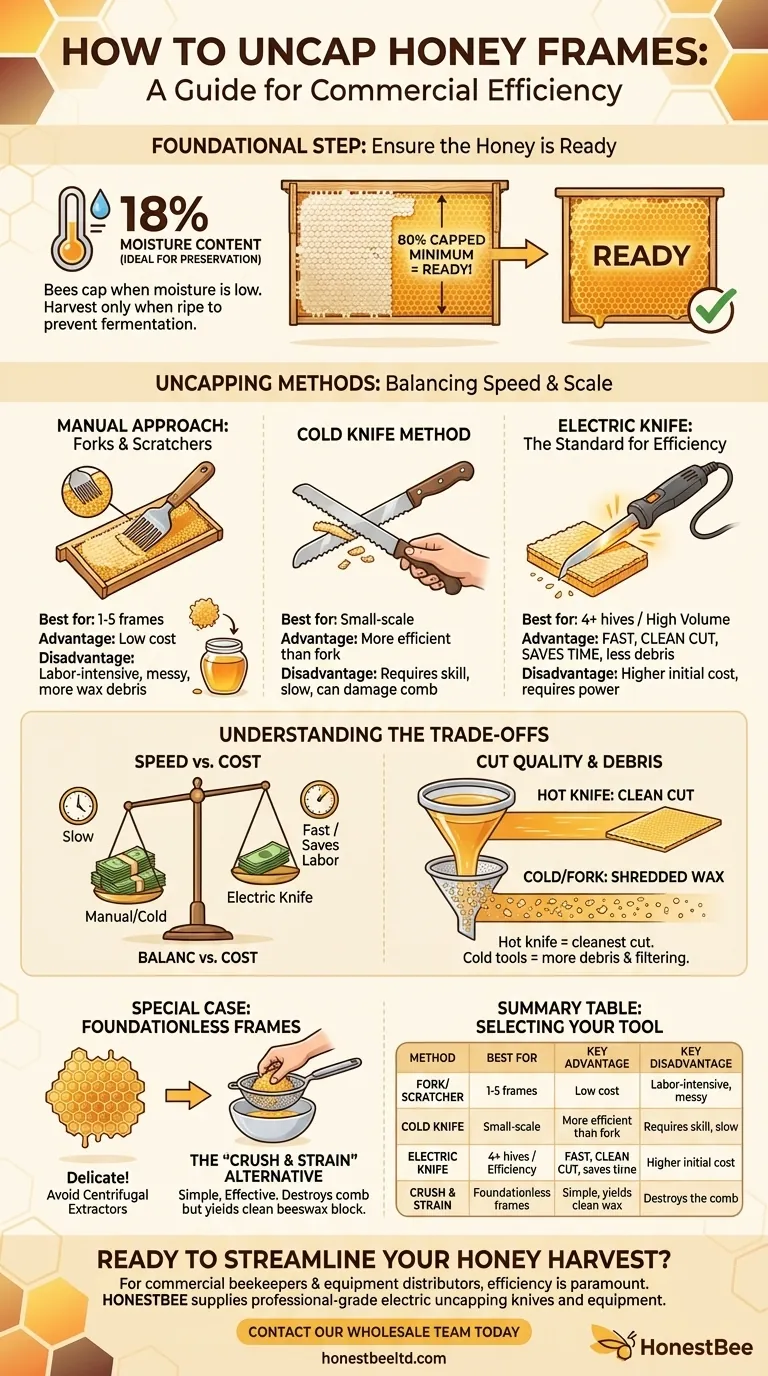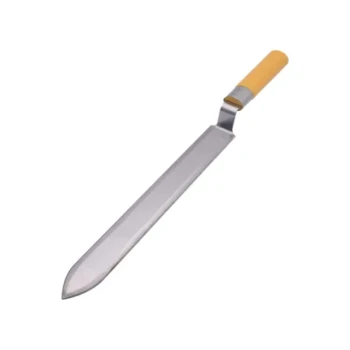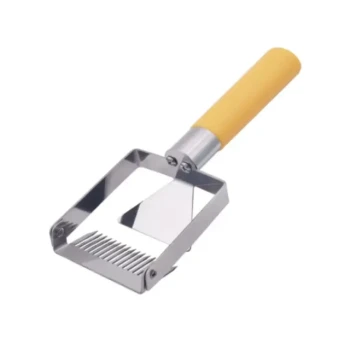To uncap honey frames, you must slice or puncture the thin layer of beeswax covering the honeycomb cells. This is most commonly done using a heated electric knife for a fast, clean cut, a long serrated knife used with a sawing motion, or a specialized fork or scratcher to pierce the cappings. The goal is to remove only the wax cap, exposing the honey for extraction without damaging the underlying comb.
The method you choose for uncapping honey is a direct trade-off between speed, cost, and the scale of your operation. While a simple fork or cold knife works for a few frames, an electric knife is the standard for efficiency when processing numerous hives.

Foundational Step: Ensure the Honey is Ready
Before any cutting begins, you must confirm the honey is "ripe." Harvesting honey with too high a moisture content will lead to fermentation and spoilage.
The Significance of Capped Honey
Bees cap cells of honey only when its moisture content has been reduced to the correct level, typically around 18%. This natural process ensures the honey will remain preserved indefinitely.
How to Check for Readiness
A frame is considered ready for harvest when it is at least 80% capped with white beeswax. Fully capped frames are the ideal, providing a clear signal that the honey inside is ready for extraction.
Uncapping Methods: From Small-Scale to High-Volume
Your choice of tool should align directly with the number of frames you need to process.
The Manual Approach: Forks and Scratchers
A cappings scratcher or fork uses stainless steel tines to pierce and pull off the wax cappings.
This method is best suited for beekeepers with very few frames (e.g., 1-5). While it is low-cost, it is labor-intensive and can be messy, leaving more wax particles in the honey.
The Cold Knife Method
A long, serrated knife, such as a bread knife, can be used with a gentle sawing motion to slice off the cappings.
The technique requires skill. You must glide the knife just under the capping surface to avoid cutting deep into the comb and removing valuable honey. It is a step up from a fork but still relatively slow.
The Electric Knife: The Standard for Efficiency
An electric uncapping knife is heated, allowing it to melt through the wax with minimal effort. This provides a fast, clean cut that significantly speeds up the process.
This is the easiest and most efficient method for beekeepers processing multiple hives. The clean cut also means less wax debris is left in the honey, simplifying the filtering process later.
Alternative Tools: Rollers and Planes
Other specialized tools exist, such as uncapping rollers (which use spikes to puncture the cappings) and uncapping planes (which shave the cappings off). These are less common but can be effective in certain workflows.
Understanding the Trade-offs
No single method is perfect. Your decision should be based on a clear understanding of the advantages and disadvantages of each approach.
Speed vs. Cost
Manual tools like forks and cold knives are very inexpensive but slow. An electric knife requires an initial investment but pays for itself in saved time and labor, especially for larger harvests.
Cut Quality and Wax Debris
A hot knife provides the cleanest cut. It cleanly slices off the capping layer, which can be collected separately. Cold knives and scratchers tend to shred the wax, introducing more small particles into your honey that must be filtered out.
Learning Curve and Safety
Using a cold knife effectively requires practice to avoid damaging the comb. Hot tools, while easier to cut with, introduce a safety risk and require careful handling to avoid burns.
Special Case: Foundationless Frames
Frames without a plastic or wax foundation require a different approach. The comb is far more delicate and can easily be destroyed in a centrifugal extractor.
Why Extraction Can Be Risky
The force of a mechanical extractor can cause foundationless combs to break apart, especially when they are heavy with honey.
The "Crush and Strain" Alternative
For foundationless beekeeping, the crush and strain method is often more practical. This involves crushing the entire comb and straining the honey through a filter or cheesecloth. While it destroys the comb, it is simple, effective, and allows you to harvest a clean block of beeswax.
Selecting the Right Tool for Your Apiary
Your choice should be a practical decision based on the size of your apiary and your primary goal for the harvest.
- If your primary focus is harvesting from 1-3 hives: Start with a cappings scratcher or a cold serrated knife; the investment in heated tools is likely unnecessary.
- If your primary focus is efficiency and processing 4+ hives: An electric uncapping knife is the most effective tool and will save you significant time and effort.
- If your primary focus is preserving beeswax and you use foundationless frames: The crush and strain method is often the most practical approach and yields a beautiful wax harvest alongside your honey.
Understanding these methods empowers you to choose the right approach for a smooth and successful honey harvest.
Summary Table:
| Method | Best For | Key Advantage | Key Disadvantage |
|---|---|---|---|
| Fork/Scratcher | 1-5 frames | Low cost | Labor-intensive, messy |
| Cold Knife | Small-scale operations | More efficient than a fork | Requires skill, slow |
| Electric Knife | 4+ hives / Efficiency | Fast, clean cut, saves time | Higher initial cost |
| Crush & Strain | Foundationless frames | Simple, yields clean wax | Destroys the comb |
Ready to streamline your honey harvest?
As a commercial beekeeper or equipment distributor, efficiency is paramount. The right uncapping tool can save you hours of labor and improve your honey yield.
HONESTBEE supplies professional-grade beekeeping equipment to commercial apiaries and distributors through our wholesale-focused operations. We provide the reliable tools—like efficient electric uncapping knives—that help your business run smoothly and profitably.
Contact our wholesale team today to discuss your equipment needs and discover how we can support the growth of your operation.
Visual Guide

Related Products
- Professional Stainless Steel Double-Sided Honey Uncapping Knife
- Stainless Steel Pivoting Honey Uncapping Fork with Plastic Handle
- Professional Honey Uncapping Fork Tool with Customizable Tine Options
- All Stainless Steel Double Sided Pivoting Honey Uncapping Fork
- All-Stainless Steel Pivoting Honey Uncapping Fork for Beekeeping
People Also Ask
- What to use to uncap honey? Choose the Right Tool for Your Apiary
- What are the advantages of an uncapping fork? Achieve Precision Honey Harvesting for Your Apiary
- What is the best method for uncapping honey? A Guide to Speed vs. Comb Preservation
- What is an uncapping plane, and how does it differ from an electric knife? Precision vs. Speed for Beekeepers
- What is the recommended practice when using plain knives for uncapping? Master the Two-Knife Method for a Perfect Harvest



















